p.341
p.346
p.350
p.357
p.362
p.367
p.373
p.379
p.384
Analysis of Fuel Injection Parameter on Biodiesel and Diesel Spray Characteristics Using Common Rail System
Abstract:
Precise control of fuel injection is essential in modern diesel engines especially in controlling the precise injection quantity, flexible injection timing, flexible rate of injection with multiple injections and high injection pressures. It was known that the fuel-air mixing is mainly influenced by the fuel injection system and injector nozzle characteristics. Thus, mixture formation during ignition process associated with the exhaust emissions. The purpose of this study is to investigate the influence of spray characteristics on the mixture formation. In this study, common rail injector systems with different model of injector were used to simulate the actual mixture formation inside the engine chamber. The optical visualization system was constructed with a digital video camera in order to investigate the detailed behavior of mixture formation. This method can capture spray penetration length, spray angle, spray evaporation and mixture formation process clearly. The spray characteristic such as the penetration length, spray angle and spray area are increasing when the injection pressure increased. The mixture formation can be improved effectively by increasing the injection pressure.
Info:
Periodical:
Pages:
362-366
Citation:
Online since:
June 2014
Authors:
Price:
Сopyright:
© 2014 Trans Tech Publications Ltd. All Rights Reserved
Share:
Citation:


